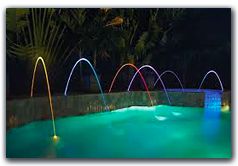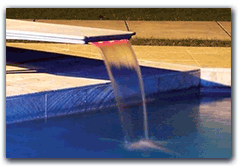FREE Standard Shipping On All Orders $100 or More!*
Plumbing Inground Pool Water Features

Water features add another dimension to an inground pool. Small fountains and bubblers are perfect for the tranquil pool, or use classic wall sconces or spouting dolphins for a more formal pool. Deck jets and water fall diving boards match a modern pool and backyard. Cascading streams or waterfalls can fit any backyard theme, from jungle to old west.
When you build an inground pool is the best time to add water features, or at least lay the pipe for future work on water features around the pool. You can always add water features later on, by running a separate pipe, or by digging up and tapping off of an existing pipe returning water to the pool.
Today's post is about how to plan plumbing and equipment and install water feature ideas on an inground pool.
Bubblers

In the bubbler category is everything from spouting sea animals, mermaids, turtles, frogs to copper or stone bowls or rock-filled planters that spill over into the pool. In many cases, bubblers sit on the edge of the pool, surrounded by various plants and flowers. Bubblers can also be placed in the floor of a tanning shelf, or shallow area of the pool, as additional returns.
Bubblers typically have a low flow requirement, around 5-10 gpm (gallons per minute), but it can vary according to size. They usually do not have a dedicated line coming from the equipment pad, but will tap off of a return pipe. Typically a reducing tee fitting is used, 1.5"x1.5"x.75 inch.
The return line pipe is cut at the point closest to the bubbler, and the tee fitting installed as a pipe coupler. From the 3/4" port on the tee fitting, 3/4" flexible PVC hose is glued, and run over and into the fountain. A 3/4" 2-way valve should be installed just before the bubbler, to allow flow control, or to shut it off completely. Smaller bubblers (spouting frog, urinating boy), may use hose as small as 3/8" for water supply and need only 1-2 gpm.
Wall Sconces

For the inground pool with a raised wall over one side of the pool, wall sconces have classic appeal. They can be a lion's face, or larger stone bowls, scuppers, or open spillways. There are so many ways to make a wall sconce, and with a variety of materials, to match your pool design, and are used to enhance a Mediterranean, modern, southwestern or natural theme.
Wall sconces may have a slightly larger flow requirement than bubblers, depending on how many you use, and how much water you like to see flowing. Each sconce may need around 5-10 gpm, depending on size.
Typically, wall sconces have a dedicated line, that runs from the return side of the pool equipment. The wall sconce plumbing line connects into a 3-way valve on the return side manifold, to allow the user to divert water from the normal wall returns, to the wall sconce returns.
From the valve installed at the equipment pad, a 1.5" line can be run over to a point behind the raised wall, mid-point between sconces. To keep flow equal between several wall sconces, the 1.5" pipe will meet a tee fitting, where it can be distributed into equal size and length pipes, to connect to the sconce on the back of the wall. Depending on the design of the sconce, your pipe may need to run through the wall to meet the back of the sconce, or some sconces will have a hose attached to it, which runs through the wall to meet your pipe.
Deck Jets

Laminar deck jets are de rigeur for the modern pool, but also add a certain playfulness to an inground pool. They can be fitted with LED colors, for lighted streams of water that shoot up over the deck and into the pool. Special non-turbulent design, and nozzles deliver a tight stream of water with air removed, so clear you can see through it.
Depending on how many deck jets you have and how high and far you need the arc of water to be, the flow requirement will vary. Each deck jet uses about 10 gpm, and they are fed by a dedicated pipe from the equipment pad. A valve allows the user to send water to the deck jets, or it can be automated with valve actuators and a controller.
When installing several deck jets, 1" PVC pipe is used to run between the "buckets", or the housing of the deck jet, which mounts flush with your pool deck. A throttling plug is also installed between each bucket, to allow for balancing the flow between deck jets.
A deck jet system should have a small secondary filter (cartridge filter) installed on the line, to remove small debris before it reaches the housing. The main feed line from the equipment pad to a deck jet distribution manifold is 1.5", or 2" is used when several deck jets are installed. And when 6 or more jets are used, a secondary pump with it's own pool suction intake may be required or desirable.
Cascades & Waterfalls

A cascade is when water rolls over several rocks or slabs before it tumbles into the pool. A waterfall, on the other hand, may have one or two tumbles, but at the end has a fall of several feet into the pool. Less tumbling, more falling.
Cascades and waterfalls require the most flow of all water features, however like the rest, it depends on how it is constructed. A small, trickling waterfall will need just 5-15 gpm, but a large cascade or waterfall can use 50-150 gpm. Surface calculations can be made to estimate the desired volume of water flow. It's best to overestimate the amount needed, and use a valve to throttle flow to the waterfall.
Another main drain type suction port is installed in the deep end of the pool to supply water to the waterfall pump, and a 2" or 1.5" line is run from the pump to the waterfall, with a throttling valve installed after the pump. Some pool pumps are sold as "waterfall pumps", but just about any pool pump can be used to power a waterfall, though all pumps produce different flow rates. Consult the pump flow curve, with an estimate of the total head for the waterfall system, to use the smallest [most economical] pump that will do the job. Call us if you need assistance with the calculations and pump selection.
Diving Board

Yes, diving boards such as the Inter-Fab T7, or the Duro-beam Aquaboard are now fitted with a pipe connector on the underside to connect a 1" feed pipe, with a stylish waterfall at the end of the diving board. They can also be fitted with color LED lighting, for a dramatic and modern effect.
The water flow requirement for waterfall diving boards is 8-15 gpm, depending on how strong you want the water to flow out. At 15 gpm, it comes out as a solid sheet, but at half the amount the water fall becomes more of a tranquil trickle.
These are generally just plumbed from the return line, or as an additional pool return, with a small valve placed safely under the diving board, or just off the pool deck, to allow for flow control or shutting it off completely.
To add a waterfall diving board to an existing Type I inground pool, you would dig up the nearest pool return pipe and install a tee fitting, then trench a pipe from that point to a point where it comes up out of the deck underneath the rear of the diving board. Connect into the board with 1" flex pipe, and a 1" ball valve.
Slide

Today's slides have high volume water systems, as compared to the slides of yesteryear, which usually had a garden hose running across the deck, or some with a spigot installed below the ladder leg. Slides like the X-Stream and the G-Force require a 1" line plumbed from the pool return, which comes up right below the ladder, with a 1" valve to control flow.
Alternatively, you can install it from your home's water system, and use your slide as a way to add water to the pool without dragging out the hose. The downside is that if you use the slide for long, you may overfill your pool, and need to drain water out.
Smaller slides can still use a garden hose, attached at the bottom, and the Zoomerang has an attachment hose that connects to the pool return line, the patented "Zoom Flume".
When you plan your pool with the ITS Pool Experts, we will help you design any water feature that you want to add to the pool - without charge! The added-value is our 100% free and unlimited tech support during planning, construction and start-up - from Layout to Landscaping, as I like to say.